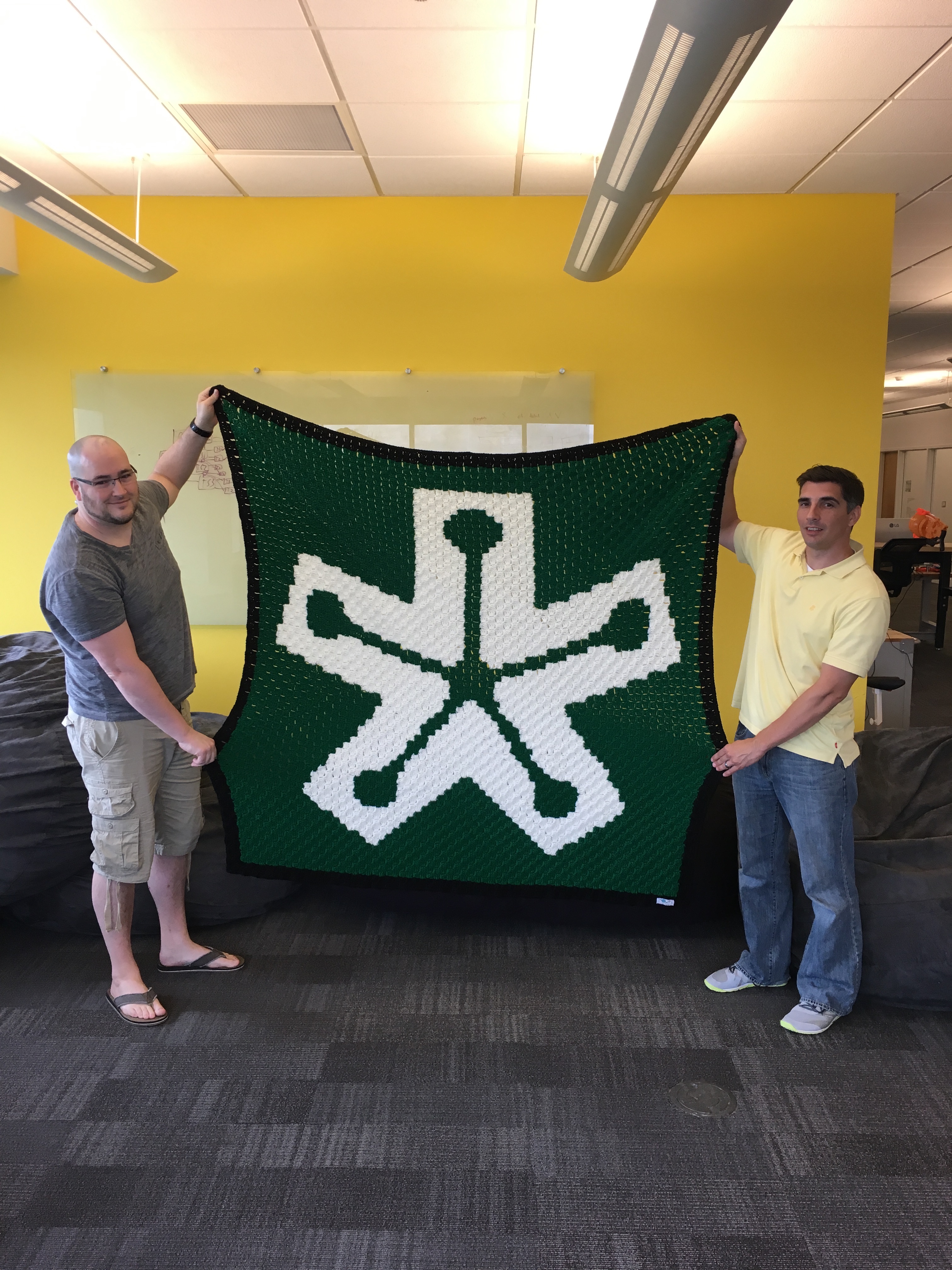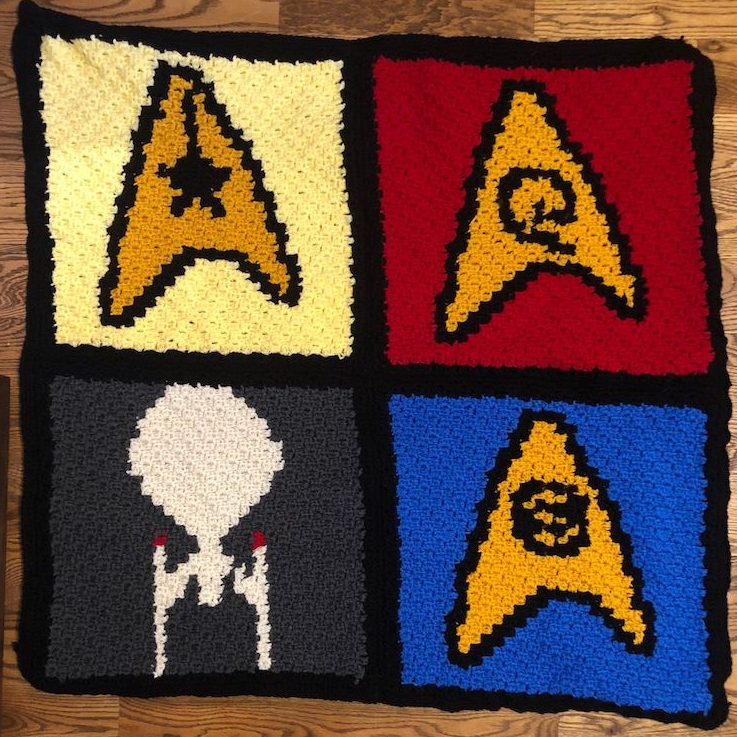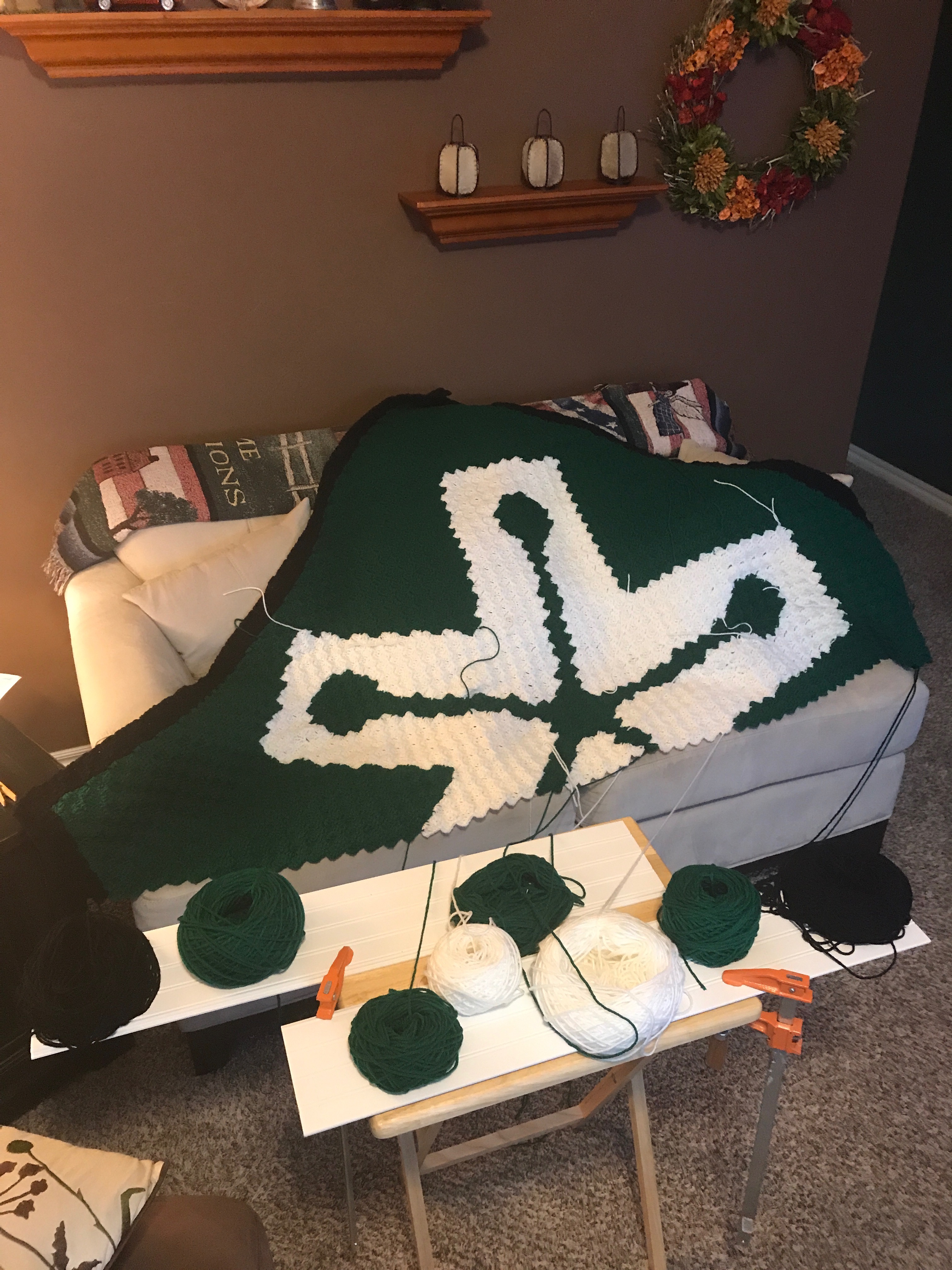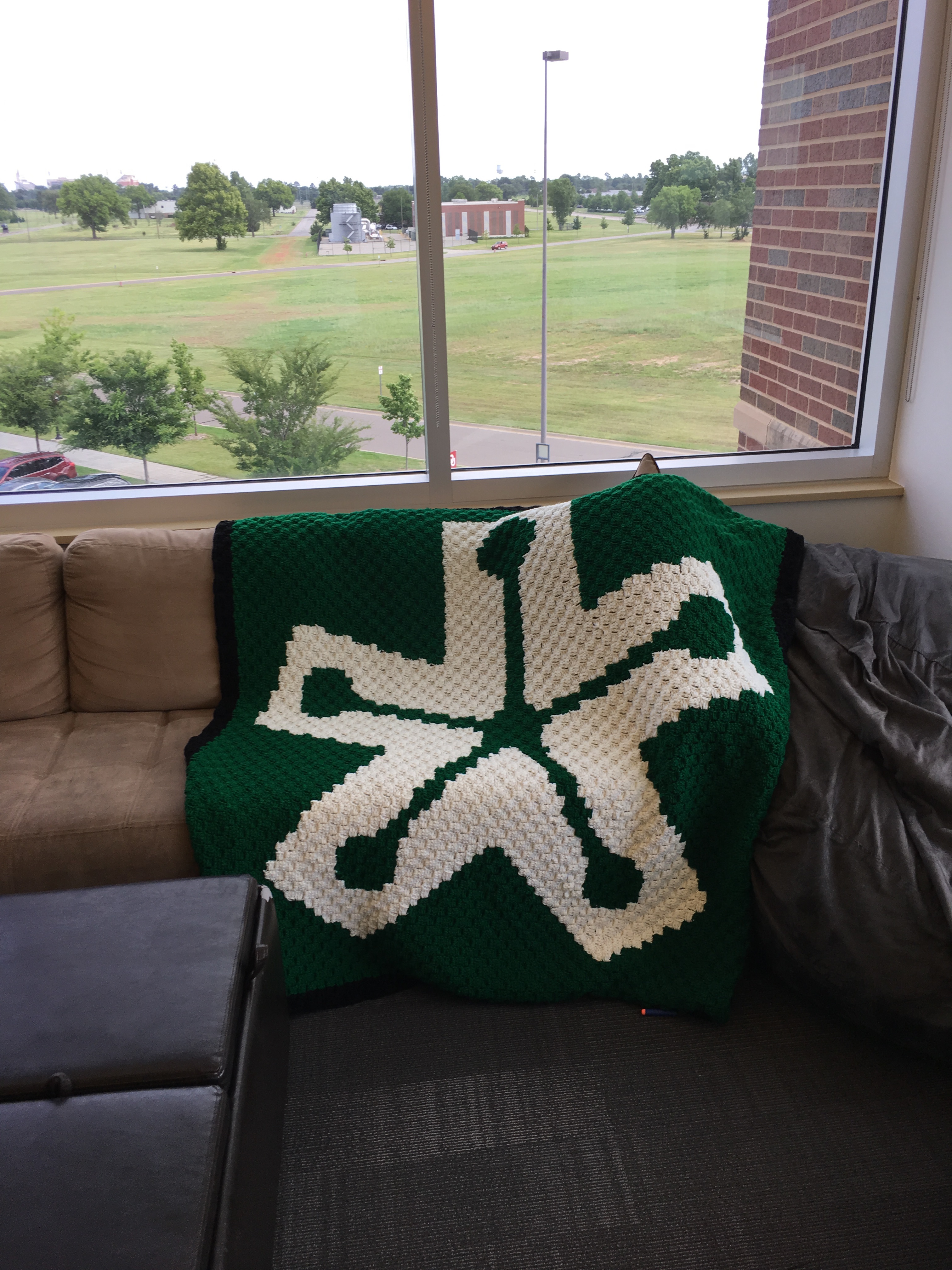Since its inception in 2011, NextThought has used the same star-shaped logo created by Whitney Martin Design. The logo has taken many forms and appeared in many places over the years: mugs, hats, stress balls, business cards, shirts, gym bags, this blog—the list goes on and on. But could it be re-created in yarn?
Spoiler alert: yes. Yes it could.
Nerding Out with C2C

Spoiler: The finished afghan, which is about 5'x5'.

My finished TOS grapghan.
I'm a programmer, I'm a nerd, and I crochet as a hobby. So when I came across the The Star Trek Laphghan project on Two Hearts Crochet, I was super excited to try it.
It introduced me to a style of crochet called "corner to corner" (C2C). In this style, instead of working row by row, from the bottom to the top, you start at a corner and work diagonally. You're building a triangle until you get to the middle, and then you're shrinking the triangle until you get to the opposite corner. Each diagonal row is made of a series of individual "blocks," one block for the corner, two blocks for the next diagonal, three after that, and so on. This makes it easy to use multiple colors of yarn and switch between them as needed to create complex designs.
On any given diagonal row, there will be as many different yarns attached as there are color changes. Because crochet is worked right to left, when you finish a diagonal row by working as far left as you can, you flip the whole in-progress piece over so that you can start back from right to left (think of it like an old manual typewriter where the carriage returns from the end of a line to start the next one); this will be important later.
This appealed to me as a programmer because I could think of each block as a "pixel" like in computer graphics. Indeed, the general name for such crochet projects is "graphgan", a portmanteau of "graphic" and "afghan"). The possibilities were limitless!
The Star Trek lagghan (a small afghan, sized as a lap blanket) is made up of four individual square graphgan panels that are then attached together to make the finished piece. Each panel is about 18 inches, and the finished lapghan is about three feet square.
Scaling is Hard

The NextThought logo graphic I started from.
After I finished the laphgan, I started hunting for my next project.
The NextThought offices have what we call a cozy-corner™ with some couches and beanbag chairs, where people can go to brainstorm or just get away from their desk for awhile. I thought a blanket might go well in that corner. Naturally it would have to incorporate the NextThought logo, and naturally (since I had just done so much with it) it would be done in C2C. I wanted the blanket to be big enough to be useful, but not so big it would be too bulky to have around so I decided to target around a five foot square.
The first step was to come up with the pattern or instructions. Graphgan patterns can be given in a grid-like graph, but I prefer a textual form that gives the number of crochet stitches in each color, for each row.
The grapghan graph
Since I had a logo graphic to start from, and each pixel in the graphic (appropriately cropped) would translate to a block in the crochet pattern, I thought about writing a program that would take the image as input, and go through it diagonally and produce the instructions for me.
Scaling Down is Hard
Then, being lazy, I looked to see if someone had already written that program and discovered that they had: Stitch Fiddle. There was just one problem. The beautiful, high-resolution image I started from wasn't so pretty when down-scaled to the low-resolution pixels that could be achieved in crochet (something that I'm sure any pixel artist could have told me). Fortunately, Stitch Fiddle provided a GUI to adjust the grid and I tweaked it as best I could. Soon I had a set of instructions:
w: White G: Green B: Black ← Row 1: 1B (1 stitch) → Row 2: 2B (2 stitches) ← Row 3: 3B (3 stitches) → Row 4: 4B (4 stitches) ← Row 5: 2B, 1G, 2B (5 stitches) → Row 6: 2B, 2G, 2B (6 stitches) ← Row 7: 2B, 3G, 2B (7 stitches) → Row 8: 2B, 4G, 2B (8 stitches) ← Row 9: 2B, 5G, 2B (9 stitches) ... → Row 64: 2B, 9G, 3w, 6G, 10w, 2G, 3w, 3G, 11w, 13G, 2B (64 stitches) ← Row 65: 2B, 15G, 10w, 3G, 2w, 2G, 7w, 10G, 3w, 9G, 2B (65 stitches) → Row 66: 2B, 10G, 3w, 12G, 4w, 6G, 11w, 16G, 2B (66 stitches) ← Row 67: 2B, 18G, 10w, 14G, 4w, 3G, 4w, 10G, 2B (67 stitches) → Row 68: 2B, 10G, 5w, 2G, 7w, 10G, 11w, 19G, 2B (68 stitches) ← Row 69: 2B, 21G, 10w, 6G, 17w, 11G, 2B (69 stitches) → Row 70: 2B, 11G, 19w, 5G, 9w, 22G, 2B (70 stitches) Corner ← Row 71: 2B, 23G, 8w, 4G, 19w, 11G, 2B (69 stitches) → Row 72: 2B, 10G, 20w, 4G, 7w, 23G, 2B (68 stitches) ← Row 73: 2B, 22G, 7w, 5G, 19w, 10G, 2B (67 stitches) ... → Row 136: 4B (4 stitches) ← Row 137: 3B (3 stitches) → Row 138: 2B (2 stitches) ← Row 139: 1B (1 stitch) Done
Near the widest part of the graphgan, right across the diagonal through the center of the NextThought star, there would be 11 color changes, meaning there would be 11 strands of yarn attached.
Scaling Up is Hard
Remember when I said above that you have to flip the entire blanket at the end of each row? And remember how I said that the blanket would be five feet square, making the widest diagonal about seven feet long?
If you remembered, good for you. I didn't remember. It turns out it's pretty hard to flip a blanket that's 5'x5'x7' with 11 strands of yarn attached to it. Much harder than flipping an 18" square.

The graphgan in progress.
To solve these problems, I improvised a wide, movable work area out of a TV tray extended with clamped on "wings" made of paneling. Flipping the blanket involved very carefully bundling it up, lifting it over the tray and holding it still while I walked myself around to a different chair on the other side of the tray to work on the next row. This was an annoying process that tended to break my "flow." Often I'd get to the end of a row and just quit rather than deal with flipping.
Finishing Up

The graphgan at home in the cozy-corner™.
Overall, the blanket took about 5 months from start to finish working in the evenings and weekends (although I didn't work on it every day, and there were even a couple periods where I didn't work on it at all for a week or more).
I'm very pleased with the way it turned out, but I learned that complex C2C designs do not scale up well to a project of this size, something I should have thought about before I started. While I may do smaller C2C projects in the future, I don't plan to tackle something of this size ever again!